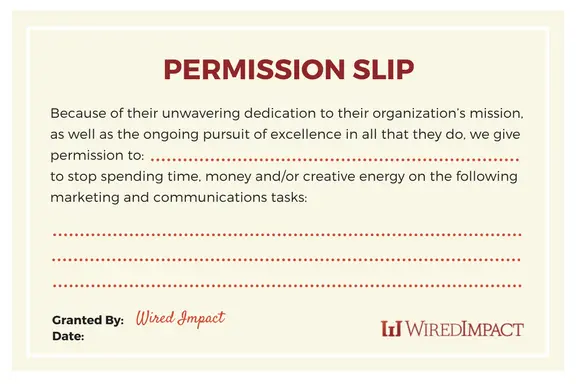We’re not mad, just a little disappointed. You see, there are a lot (maybe too many) ideas out there for nonprofit marketing. Some of them just aren’t worth it, and haven’t been for awhile, but we still see them happening. If you need a bit of convincing to stop doing something in your marketing, or know in your heart that you’ve been led astray and need permission to stop, we’re ready to help.
Busy nonprofit marketers can better prioritize their time and budgets when it’s easy to say no to things that don’t work. By weeding out the good from the bad, you’ll be able to take on projects and ideas that have more potential.
The Stop This Sh*t List
In case it’s unclear how passionate we are about this topic, our list is named in no uncertain terms. To get you on the right path, here are marketing mistakes you should stop making, backed by research and best practices for nonprofits.
1. Planning Projects Without Concrete Goals
According to the Digital Outlook Report, an estimated 32% of nonprofits have a written strategy for their digital marketing program. Without a solid strategy that defines clear goals, your marketing projects or campaigns are susceptible to taking on tactics and creating products that won’t actually deliver.
Learn how to set better marketing goals and goals that don’t suck by starting with your overall organizational goals, getting more specific, considering your marketing tools, and setting reasonable expectations.
2. Measuring Your Success by Dumb (or No) Metrics
In the latest Nonprofit Communications Trends Report, nonprofits gave themselves poor grades when it comes to identifying and using key performance indicators (KPIs). Unsurprisingly, the same report found that many nonprofits don’t think their communications are effective.
But don’t just fall into the trap of using numbers that don’t mean anything. Vanity metrics may be pretty to look at but aren’t actionable, like the number of Facebook followers or post shares. On their own, these numbers shouldn’t inform decisions about what’s working. Instead, measure your marketing strategy by quantifiable metrics that relate back to your goals, like the number of Facebook followers who make online donations. Even board reports are better with good metrics.
3. Organizing Web Pages Based on Your Needs
Time and time again, we see websites where the nonprofit mimics their organizational (or team) structure to decide how to present information. However, your staff is not your target audience, and your internal divisions and processes likely don’t matter much to someone looking for help or how to get involved.
Put users first when it comes to deciding your website structure. In fact, we recently published an entire guide about website structures that can help! When you make visitors a priority, you have a better chance of getting your message across. But, word of caution, don’t go so far as to create an audience-based navigation. Yikes.
4. Cluttering and Hiding Your Homepage
Organizations can be so cruel to their homepages. First, they cut the link to their homepage from the navigation. This link is crucial for users to find their way, especially when a search engine sends someone to a page on your site that’s not the homepage. Second, homepage content becomes cluttered with multiple calls-to-action and no clear statement about your mission and programs. Give newcomers a chance to get to know you.
And then there’s the image rotator. This isn’t the first time we’ve asked nicely to cut out image rotators, so if you still need a little convincing, research from the Nielsen Norman Group explains why carousel-like content doesn’t have the intended effect. (Hint: It’s annoying.)
5. Using Your Blog and Emails to Share Boring Internal News
If a press release is sent to your full email list, you’re doing it wrong. The same goes for staff announcements, office makeovers, and newly awarded funds. Unless you can tell people how a piece of news is valuable to them, it’s not worth it.
The 2017 Member Loyalty Study found that some of the biggest content frustrations have to do with information that doesn’t seem to pertain to readers or that is flat out dull or boring. Along the same lines, Abila’s Donor Loyalty Study found that 71% of donors feel more in tune with a nonprofit when the content is more customized and relevant to them personally.
To find better ways of communicating through your blog and email, check out our tips for email fundraising content, segmenting your email list and ways to avoid common blogging mistakes.
6. Trying to “Go Viral” or Reach the “General Public”
If your nonprofit has already set effective marketing goals, this shouldn’t really be a problem. But if you’re constantly having to explain why your organization isn’t going to do the next Ice Bucket Challenge, we have some battle tools at your disposal.
The main problem here is that these viral or awareness-building campaigns don’t offer lasting (or any) success for the average nonprofit. “Raising awareness” doesn’t translate to taking action. In terms of retention, only 21% of first time online donors are likely to stick around and give again the next year. And not many people are seeing your Facebook content to start with.
Rather than going big, go strategic. Create target audience personas and zero in on the messages and tactics that will specifically motivate them to support your cause.
7. Scrambling to be Social Media Wizards
The 2017 Global NGO Online Technology Report tells us that most nonprofits around the world are on Facebook and Twitter. But despite this widespread use, only 32% have a written strategy and nearly half of nonprofits say their executive staff don’t have the right knowledge. Without enough focus, skills and time, why spread yourself thin over every platform?
Once you have target audience personas in place, take the time to learn the facts about social media usage and the general demographics of social media platforms. Stick to what works for your audience and the content you have to offer — then let the rest go.
8. Hoarding Subscribers on Your Mailing List
Building your nonprofit’s email list is an important task that’s likely to have returns with effective email marketing. But there’s only so much you can do for someone who is not interested in opening your emails. Deleting people from your email list sounds scary, but there are fundraising consequences to letting your list grow wild.
Don’t keep inactive subscribers hanging around for too long. This can cost you money as well as make it hard to see what’s working in your email strategy for people that actually care. If they won’t re-engage with a targeted email campaign, set them free!
9. Only Contacting Supporters When You Need Something
Many nonprofits are reluctant to send what they think are too many pieces of communication. This can result in only sending messages that you deem most important, like fundraising appeals and the occasional big news update. That’s not much, if any, room for building relationships and cultivating people to be closer to your organization.
Tell your supporters about the impact they are having through compelling stories and emails focused on donor retention. One study found that about 75% of donors would consider ending their support based on poor content. Don’t make your content an afterthought.
10. Moving Everything to Digital
As much as we love digital projects, there are some things that are more meaningful and effective when done offline. Depending on your target audience and goals, in-person meetings, fundraising letters and print newsletters could be the way to go.
For example, according to the Donor Loyalty Study, 75% of donors like short emails but 73% also like short letters, 56% want a printed annual report and 53% still prefer long-form articles. Considering that fundraising from online giving only makes up 6.2% of total fundraising for small nonprofits, offline marketing tactics are here to stay and should be used in coordination with digital projects.
To learn more about this ongoing love affair with the non-digital life, pick up a copy of The Revenge of Analog: Real Things and Why They Matter by David Dax. It’s a good reminder for all of us marketers!
Cutting Out the Nonsense
Was there anything on the list that surprised you or gave you a sense of relief? We know you don’t have time for all of this nonsense, so we hope that the research and resources help you move forward with your marketing.
That said, we know that marketing strategies often have a history. Maybe it was something you inherited from a predecessor in the same role, or that you were instructed to do by a supervisor. If there’s an outdated strategy that worked for you in the past, it can be hard to give yourself permission to let go.
Whatever the case, it’s important to have calm, honest and professional discussions about the marketing nonsense that you’d like to cut, especially when working with people on other teams, with volunteers or alongside partner organizations. And be kind to yourself about the things you realize you need to change.
Permission Granted!
When you’re ready to give the heave-ho to bad marketing strategies at your nonprofit, we have just the thing for you. Fill out our permission slip as a reminder of your commitment! Click on the image to access a PDF version in a new window — or right-click to save it.
You can print it and hang it above your desk, bring it to meetings, or email it to a colleague that might need help finding the courage to stop doing something that isn’t worth it.
Is there anything you want to add to the Stop This Sh*t List for nonprofit marketers? What’s something that you’ve stopped doing recently? We’d love to hear your thoughts and ideas in the comments.


Great article, full of convicting points as we work on a content strategy process for our websites.
Thanks, Ross! I’m glad it was helpful.